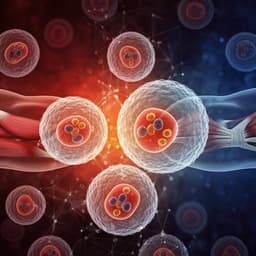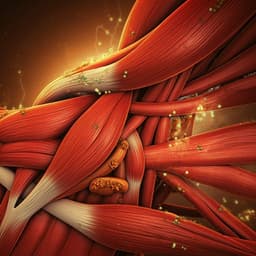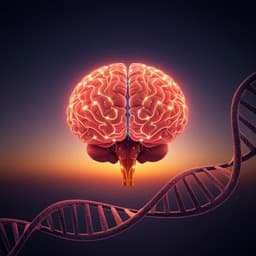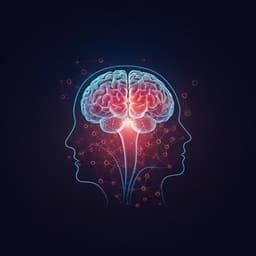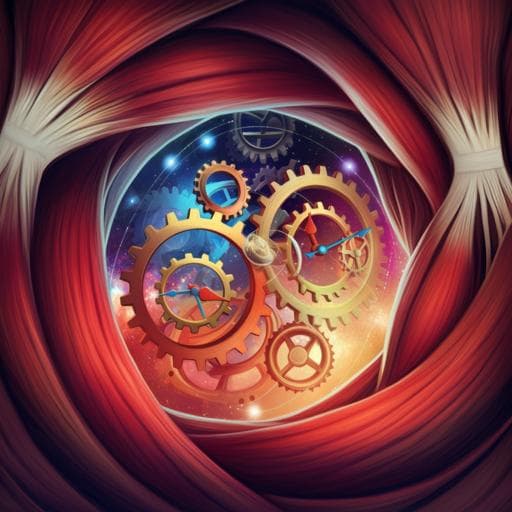
Space Sciences
Skeletal muscle gene expression dysregulation in long-term spaceflights and aging is clock-dependent
D. Malhan, M. Yalçin, et al.
This groundbreaking research by Deeksha Malhan, Müge Yalçin, Britt Schoenrock, Dieter Blottner, and Angela Relógio uncovers how circadian clock disruptions during long-term spaceflights and aging affect skeletal muscle gene expression. The study reveals critical insights into combating musculoskeletal atrophy in astronauts by maintaining circadian function through factors like exercise and fasting.
~3 min • Beginner • English
Introduction
The study addresses how disruptions of the circadian clock contribute to skeletal muscle dysregulation during long-term spaceflight and whether these alterations resemble aging-related changes on Earth. The authors contextualize that skeletal muscle mass and function are circadian-regulated and sensitive to environmental Zeitgebers (light, feeding, exercise). Aging, bedrest, and spaceflight are associated with muscle atrophy and circadian misalignment. The purpose is to systematically characterize clock-dependent molecular changes in skeletal muscle under spaceflight, aging, and Zeitgeber interventions, and to assess whether exercise timing/intensity or fasting could mitigate spaceflight-induced dysregulation. This is important for astronaut health and performance on prolonged missions and for managing age-related sarcopenia on Earth.
Literature Review
Background highlights include: circadian regulation of thousands of muscle-related genes; central (SCN) and peripheral clocks entrained by Zeitgebers; core transcriptional-translational feedback loops (BMAL1/CLOCK driving PER/CRY; RORs vs NR1D1/2 fine-tuning). Prior work shows muscle clock importance (BMAL1 loss causes sarcopenia), aging reduces circadian amplitude and alters phase, and microgravity/bedrest induce muscle loss and circadian phase delays in body temperature. Spaceflight studies reported altered circadian signaling in peripheral tissues, but skeletal muscle-specific molecular characterization was lacking. Exercise timing affects muscle gene expression; fasting influences muscle stem cell quiescence; countermeasures (exercise, nutrition, time-restricted feeding) have shown benefits in microgravity analogues. These findings motivate an omics-based, multi-condition analysis of clock-muscle interactions.
Methodology
The authors conducted a systematic re-analysis of 28 published omics datasets (RNA-seq, microarray, LC-MS) from mammalian skeletal muscle tissues/cells across conditions: healthy circadian time-courses (human, mouse), clock perturbations (human CLOCK knockdown myotubes; mouse muscle-specific Bmal1 knockout; Clock mutant), spaceflight (mice at 11, 30, 33, 37 days), hypergravity (3 g), bedrest (human males and females, 9–90 days, with/without countermeasures), aging (human skeletal muscle across age groups), exercise (timing/intensity/types in mice, rats, humans), and fasting (mouse 24 h). Data acquisition: raw fastq from GEO, microarray raw CEL/TXT from GEO, proteomics raw intensities from PRIDE; spaceflight data from NASA GeneLab and GEO. RNA-seq: quality control with FastQC/fastqcr; adapter trimming with Trimmomatic; alignment to species genomes (GRCh38, GRCm39, mRatBN7.2) via STAR; quantification via Salmon; import with tximport; TMM normalization (edgeR); feature filtering (≥0.5 CPM average). Microarray: preprocessing with limma/oligo, RMA normalization, quality control with ArrayQualityMetrics, platform-based annotation, probe selection by highest average expression. Proteomics: MaxQuant processing; label-free normalization and differential analysis with Proteus. Rhythmicity analysis: RAIN to detect ~24 h rhythms (q<0.05 BH-corrected), acrophase/amplitude via Cosinor (DiscoRhythm). Differential rhythmicity: LimoRhyde comparing perturbed vs control (e.g., KO vs WT; fasting vs fed) to identify phase shifts, loss/gain of rhythmicity (q<0.05). Differential expression: limma (within LimoRhyde for circadian designs where appropriate) on RNA-seq and microarray; Proteus/limma for proteomics; significance threshold nominal p<0.01 and |logFC|≥0.2. Network analysis: Cytoscape with STRING interactions and MCODE clustering to integrate common DE genes between long-term spaceflight (37d) and aging, expanded to include core-clock nodes. Pathway curation: KEGG and Reactome pathways relevant to skeletal muscle (e.g., mTOR, MAPK, PI3K-Akt, calcium signaling, oxidative phosphorylation, myogenesis, contraction, mitochondrial biogenesis, FoxO, insulin signaling/resistance, heat stress) and circadian pathways (circadian rhythm/entrainment, circadian clock), plus curated myonuclei-related genes and a published network of clock-regulated genes (NCRG). Correlation analyses: Pearson correlations among core-clock genes in spaceflight and aging cohorts with rcorr for significance. All datasets and software versions are enumerated; analyses used consistent pipelines to minimize discrepancies across studies.
Key Findings
- Circadian regulation in skeletal muscle: Many genes of interest, including SUN2, HMOX1, WWTR1, NR1D1 (humans) and Sun2, Hmox1, Wwtr1, Rora (mice), exhibit ~24 h rhythmicity. Inter-individual differences in acrophases were observed in human biopsies.
- Clock perturbations alter rhythmicity and expression: In human myotubes, CLOCK knockdown led to donor-specific phase shifts (e.g., COX6C, TGFA) and upregulation of CRY1, MYOG, MYH3 with downregulation of NR1D1/CLOCK/NR1D2/MEF2A. In mice, mBmal1KO and Clock mutant muscles showed significant phase shifts (>4 h; q<0.05) in 87 genes, including Nr1d2, Arntl, Prkab2, Gabarapl1, Atg12; loss of rhythmicity in Cry2 and other core-clock components.
- Spaceflight duration correlates with dysregulation magnitude: Spaceflights of 30–37 days caused far more differentially expressed skeletal muscle genes (30d: 548; 33d: 430; 37d: 550 in at least one dataset) than 11 days (61). Core-clock genes showed duration-dependent changes: Arntl, Clock, Cry1, Npas2 upregulated; Cry2, Nr1d2, Per2, Per3 downregulated (33–37 days). Muscle genes Myod1, Nfat5, Fos upregulated; Dbp downregulated across long durations; Cdkn1a upregulated; Ppara downregulated across all spaceflight durations. Proteomics showed limited DE proteins at 14 days (2) and many at 30 days (307 in at least one dataset). Ryr3 transcript downregulated at 37 days microgravity but protein upregulated under hypergravity (3 g, 28 days).
- Bedrest shows analogous patterns: In bedrest datasets, PER1 and RORA were upregulated, while ALAS1, HIPK2, CALU, BHLHE41 were downregulated in at least one dataset; PER2 was downregulated and PER3 upregulated, suggesting core-clock compensation. ACTN2 was downregulated in bedrest.
- Overlap with circadian programs: Of 5017 DE genes in long-term spaceflight (37d), 3001 were circadian in at least one WT mouse time-course; among predefined genes of interest, 760 were DE and 550 were circadian in WT datasets. Core-clock (Arntl, Clock, Cry1/2, Npas2, Nr1d1/2, Per1/2/3, Rora/Rorc) and myogenic genes (Myod1, Myh3/9/10, Atf4/5/6) were both DE in spaceflight and circadian in WT.
- Aging parallels spaceflight: Across human aging cohorts, 76 DE genes in at least one age group (58 replicated in an independent dataset). MYH8 increased with age across groups; ACTN3 and ATP2A1 decreased in older groups; KCND3 increased. Additional age-related changes included upregulation of CDKN1A, SOX9, KCNMA1 and downregulation of MYLK4. Correlations among core-clock genes shifted with age (e.g., ARNTL–PER1, NR1D2–RORA). Common DE genes in aging and spaceflight included 129 upregulated (e.g., CASQ2, FGF1) and 113 downregulated (e.g., NOS1, FABP3, FGF13), indicating shared molecular signatures.
- Zeitgebers as potential countermeasures: Exercise effects depended on time (ZT14 vs ZT22) and intensity (basal/moderate/high), with common DE genes including Nfe2l2 and Cdkn1a (ZT14) and Nfe2l2 and Per2 (ZT22). Human training induced age- and modality-dependent changes; in older subjects, PER2, PER3, CRY2, NR1D1 were downregulated in at least one exercise group. Fasting (24 h) increased the number of ~24 h rhythmic genes (723 vs 337 fed), altered acrophase/amplitude distribution, and induced DE patterns: upregulation of Per1, Myh3, Dctn2, Npas2, Rorc, Mtor, Sun1, Cry2; downregulation of Myod1, Cry1, Per3, Dbp. Notably, Rorc was downregulated in spaceflight/aging but upregulated with fasting; Atf4 was downregulated in spaceflight/aging but upregulated with fasting (and downregulated after some high-intensity exercise), suggesting potential reversal of detrimental signatures.
- Networks of shared dysregulation: 206 genes were commonly DE between long-term spaceflight (37d) and aging; network integration with core-clock nodes highlighted Arntl, Bhlhe40, Cry2, Rorc and muscle genes (Wnt5a, Atf4, Vegfb, Cdkn1a, Myl2, Ndufa4l2, Fabp3, Ndufb3, Fgf2, Cul3, Acta2, Lep, Actn3, Hspa8) as central. Opposing regulation under fasting/exercise vs spaceflight/aging for several nodes supports Zeitgeber-based countermeasure strategies.
Discussion
The findings demonstrate that skeletal muscle pathways are tightly regulated by the circadian clock and that long-duration microgravity disrupts core-clock components and muscle-associated gene networks in ways that mirror aging-related molecular changes. This supports the hypothesis that spaceflight accelerates a clock-dependent, sarcopenia-like phenotype. The observation that many spaceflight DE genes are circadian in healthy tissue indicates that time-of-day regulation underlies susceptibility. Exercise timing/intensity and fasting modulate core-clock and muscle genes, in some cases opposing spaceflight/aging trends (e.g., Rorc, Atf4, Fabp3, Wnt5a, Ndufa4l2), suggesting potential mitigation strategies via Zeitgebers. The work emphasizes the importance of maintaining circadian alignment to preserve muscle mass and function during space missions and highlights targets for countermeasures. It also underscores that bedrest, a terrestrial analogue, recapitulates many of the molecular alterations, strengthening translational relevance.
Conclusion
This study integrates multi-omics datasets to show that long-term spaceflight induces clock-dependent dysregulation of skeletal muscle pathways, resembling aging-associated gene expression changes. It identifies core-clock and muscle genes (e.g., Rorc, Atf4, Myod1, Cdkn1a, Fabp3, Ndufa4l2, Wnt5a) as key nodes and shows that external Zeitgebers (exercise timing/intensity, fasting) can shift these molecular signatures, offering candidate countermeasures to mitigate microgravity-induced muscle atrophy. Future directions include: conducting time-course circadian experiments in spaceflight and aging cohorts; validating candidate interventions (time-restricted feeding, tailored exercise schedules) in controlled studies; developing non-invasive circadian monitoring tools for astronauts; and dissecting muscle-type-specific responses to optimize personalized countermeasures for long-duration missions.
Limitations
Key limitations include reliance on single time-point sampling for most spaceflight and aging datasets, precluding full circadian phase/amplitude resolution; heterogeneity across species (mouse vs human), sexes, and muscle types (slow vs fast twitch) that may differentially respond to microgravity; varying durations and conditions across studies (e.g., habitat differences in spaceflight datasets); and the integrative nature of re-analysis, which, despite uniform pipelines, may still be impacted by batch and technical variability. Limited availability of circadian time-course datasets in aging and spaceflight contexts restricts causal inference regarding rhythmicity changes.
Related Publications
Explore these studies to deepen your understanding of the subject.



